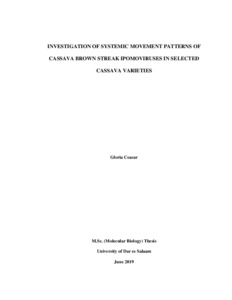| dc.contributor.author | Ceasar, G. |
| dc.date.accessioned | 2022-06-22T09:49:31Z |
| dc.date.available | 2022-06-22T09:49:31Z |
| dc.date.issued | 2019-06 |
| dc.identifier.citation | Ceasar, G. (2019). Investigation of systemic movement patterns of Cassava Brown Streak ipomoviruses in selected cassava varieties.Dar es Salaam, Tanzania: University of Dar es Salaam (78 p.). |
| dc.identifier.uri | https://hdl.handle.net/20.500.12478/7523 |
| dc.description.abstract | Cassava is among the important food security crops in Sub Saharan Africa and a major staple food for more than 800 million people in the developing world. Cassava production in Africa which is more than half of the total world production is affected by viral diseases, one being Cassava Brown Streak Disease (CBSD) caused by two distinct species of Ipomoviruses namely; cassava brown streak virus and Ugandan cassava brown streak virus collectively called cassava brown streak ipomoviruses (CBSIs). Economic losses of up to US$ 1 billion every year have been reported due to yield losses caused by CBSD and CMD. This study aimed at investigating systemic movement patterns of CBSIs from point of inoculation by whiteflies to other plant parts in different cassava varieties regarded as resistant, tolerant and susceptible to CBSD. Results showed that CBSV was detected in most plant parts in all three varieties compared to UCBSV however, percentage detection of both CBSIs at different plant parts were not statistically different (P > 0.05). The percentage of CBSV detection in plant parts of all varieties changed significantly over time (P < 0.05). Higher CBSV titres were obtained in lower plant parts 3 days after transmission (DAT) while at 14 DAT titres were higher in top plant parts than bottom parts. These differences in CBSV titre were not statistically significant (P > 0.05). This information provides preliminary information on movement patterns of CBSIs in cassava plants. Also, this study aimed at optimizing the protocol for CBSV detection by digital PCR and comparing its sensitivity against qPCR. Results show that dPCR is 1000-fold more sensitive than qPCR in CBSV detection. This work presents the first application of dPCR in detection of plant pathogens in Africa. |
| dc.format.extent | 78 p. |
| dc.language.iso | en |
| dc.publisher | University of Dar es Salaam |
| dc.subject | Cassava |
| dc.subject | Food Security |
| dc.subject | Subsaharan Africa |
| dc.subject | Varieties |
| dc.subject | Diseases |
| dc.subject | Plant Production |
| dc.subject | Yields |
| dc.title | Investigation of systemic movement patterns of Cassava Brown Streak ipomoviruses in selected cassava varieties |
| dc.type | Thesis |
| cg.contributor.crp | Roots, Tubers and Bananas |
| cg.contributor.affiliation | University of Dar es Salaam |
| cg.contributor.affiliation | International Institute of Tropical Agriculture |
| cg.coverage.region | Africa |
| cg.coverage.region | East Africa |
| cg.coverage.country | Tanzania |
| cg.coverage.hub | Eastern Africa Hub |
| cg.identifier.bibtexciteid | CEASAR:2019 |
| cg.authorship.types | CGIAR and developing country institute |
| cg.iitasubject | Agronomy |
| cg.iitasubject | Cassava |
| cg.iitasubject | Disease Control |
| cg.iitasubject | Food Security |
| cg.iitasubject | Plant Breeding |
| cg.iitasubject | Plant Diseases |
| cg.iitasubject | Plant Health |
| cg.iitasubject | Plant Production |
| cg.notes | IITA supervisor: Dr. Legg, J.P. |
| cg.publicationplace | Dar es Salaam, Tanzania |
| cg.accessibilitystatus | Limited Access |
| cg.reviewstatus | Internal Review |
| cg.usagerightslicense | Copyrighted; all rights reserved |
| cg.targetaudience | Scientists |
| cg.futureupdate.required | No |

